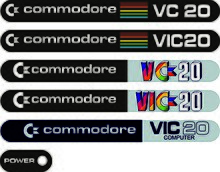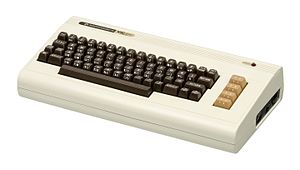VIC20
 |
|
 |
|
| Type | Home computer |
|---|---|
| Release date | 1980 (VIC-1001) / 1981 |
| Introductory price | US$299.95 (equivalent to $744.39 in 2016) |
| Discontinued | January 1985 |
| Operating system |
Commodore KERNAL/ Commodore BASIC 2.0 |
| CPU | MOS Technology 6502 @ 1.108404 MHz (PAL) @ 1.02 MHz (NTSC) |
| Memory | 20 KB ROM + 5 KB RAM (expandable to 32 KB), 3.5 KB for BASIC (expandable to 27.5 KB) |
| Graphics | VIC 176 x 184 3-bpp |
| Sound | 3 × square, 1 × noise, mono. |
| Predecessor | Commodore PET |
| Successor | Commodore 64 |
The VIC-20 (Germany: VC-20; Japan: VIC-1001) is an 8-bit home computer that was sold by Commodore Business Machines. The VIC-20 was announced in 1980, roughly three years after Commodore's first personal computer, the PET. The VIC-20 was the first computer of any description to sell one million units.
The VIC-20 was intended to be more economical than the PET computer. It was equipped with 5 KB of static RAM and used the same MOS 6502 CPU as the PET. The VIC-20's video chip, the MOS Technology VIC, was a general-purpose color video chip designed by Al Charpentier in 1977 and intended for use in inexpensive display terminals and game consoles, but Commodore could not find a market for the chip.
As the Apple II gained momentum with the advent of VisiCalc in 1979, Jack Tramiel wanted a product that would compete in the same segment, to be presented at the January 1980 CES. For this reason Chuck Peddle and Bill Seiler started to design a computer named TOI (The Other Intellect). The TOI computer failed to materialize, mostly because it required an 80-column character display which in turn required the MOS Technology 6564 chip. However, the chip could not be used in the TOI since it required very expensive static RAM to operate fast enough.
In the meantime, freshman engineer Robert Yannes at MOS Technology (then a part of Commodore) had designed a computer in his home dubbed the MicroPET and finished a prototype with some help from Al Charpentier and Charles Winterble. With the TOI unfinished, when Jack Tramiel was confronted with the MicroPET prototype, he immediately said he wanted it to be finished and ordered it to be mass-produced following a limited demonstration at the CES.
The prototype produced by Yannes had very few of the features required for a real computer, so Robert Russell at Commodore headquarters had to coordinate and finish large parts of the design under the codename Vixen. The parts contributed by Russell included a port of the operating system (kernel and BASIC interpreter) taken from John Feagans design for the Commodore PET, a character set with the characteristic PETSCII, an Atari 2600-compatible joystick interface, and a ROM cartridge port. The serial IEEE 488-derivative CBM-488 interface (which could use far cheaper cabling than a real IEEE-488 as was used on the PET) was designed by Glen Stark. Some features, like the memory add-in board, were designed by Bill Seiler. Altogether, the VIC 20 development team consisted of five people, who referred to themselves as the VIC Commandos. According to one of the development team, Neil Harris, "[W]e couldn't get any cooperation from the rest of the company who thought we were jokers because we were working late, about an hour after everyone else had left the building. We'd swipe whatever equipment we needed to get our jobs done. There was no other way to get the work done! [...] they'd discover it was missing and they would just order more stuff from the warehouse, so everybody had what they needed to do their work." At the time, Commodore had an oversupply of 1 kbit×4 SRAM chips, so Tramiel decided that these should be used in the new computer. The end result was arguably closer to the PET or TOI computers than to Yannes' prototype, albeit with a 22-column VIC chip instead of the custom chips designed for the more ambitious computers. As the amount of memory on the VIC-20's system board was very small even for 1981 standards, the design team could get away with using more expensive SRAM due to its lower power consumption, heat output, and less supporting circuitry. The original Revision A system board found in all silver-label VIC-20s used 2114 SRAMs and due to their tiny size (only 512 bytes per chip), ten of them were required to reach 5k of system RAM. The Revision B system board, found in rainbow logo VIC-20s (see below) switched to larger 2048 byte SRAMs which reduced the memory count to five chips: 2 x 2048 bytes chips + 3 x 2114 (the 1024 x 4 bits) chips.
...
Wikipedia
